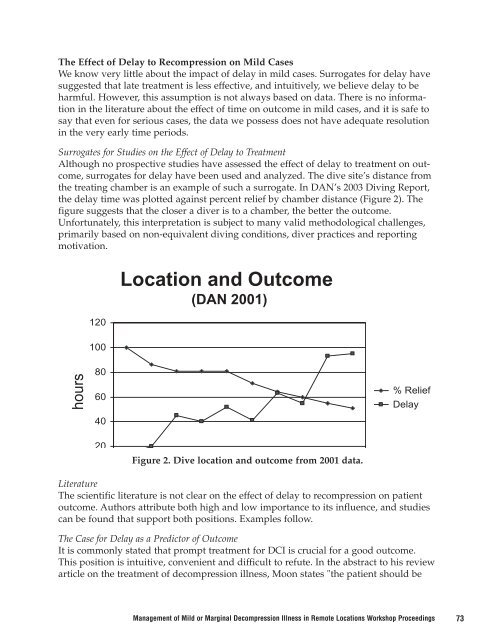Management of Mild or Marginal Decompression Illness in Remote ...
Management of Mild or Marginal Decompression Illness in Remote ...
Management of Mild or Marginal Decompression Illness in Remote ...
You also want an ePaper? Increase the reach of your titles
YUMPU automatically turns print PDFs into web optimized ePapers that Google loves.
The Effect <strong>of</strong> Delay to Recompression on <strong>Mild</strong> Cases<br />
We know very little about the impact <strong>of</strong> delay <strong>in</strong> mild cases. Surrogates f<strong>or</strong> delay have<br />
suggested that late treatment is less effective, and <strong>in</strong>tuitively, we believe delay to be<br />
harmful. However, this assumption is not always based on data. There is no <strong>in</strong>f<strong>or</strong>mation<br />
<strong>in</strong> the literature about the effect <strong>of</strong> time on outcome <strong>in</strong> mild cases, and it is safe to<br />
say that even f<strong>or</strong> serious cases, the data we possess does not have adequate resolution<br />
<strong>in</strong> the very early time periods.<br />
Surrogates f<strong>or</strong> Studies on the Effect <strong>of</strong> Delay to Treatment<br />
Although no prospective studies have assessed the effect <strong>of</strong> delay to treatment on outcome,<br />
surrogates f<strong>or</strong> delay have been used and analyzed. The dive site’s distance from<br />
the treat<strong>in</strong>g chamber is an example <strong>of</strong> such a surrogate. In DAN’s 2003 Div<strong>in</strong>g Rep<strong>or</strong>t,<br />
the delay time was plotted aga<strong>in</strong>st percent relief by chamber distance (Figure 2). The<br />
figure suggests that the closer a diver is to a chamber, the better the outcome.<br />
Unf<strong>or</strong>tunately, this <strong>in</strong>terpretation is subject to many valid methodological challenges,<br />
primarily based on non-equivalent div<strong>in</strong>g conditions, diver practices and rep<strong>or</strong>t<strong>in</strong>g<br />
motivation.<br />
120<br />
Location and Outcome<br />
(DAN 2001)<br />
100<br />
hours<br />
80<br />
60<br />
40<br />
% Relief<br />
Delay<br />
20<br />
Figure 2. Dive location and outcome from 2001 data.<br />
Literature<br />
The scientific literature is not clear on the effect <strong>of</strong> delay to recompression on patient<br />
outcome. Auth<strong>or</strong>s attribute both high and low imp<strong>or</strong>tance to its <strong>in</strong>fluence, and studies<br />
can be found that supp<strong>or</strong>t both positions. Examples follow.<br />
The Case f<strong>or</strong> Delay as a Predict<strong>or</strong> <strong>of</strong> Outcome<br />
It is commonly stated that prompt treatment f<strong>or</strong> DCI is crucial f<strong>or</strong> a good outcome.<br />
This position is <strong>in</strong>tuitive, convenient and difficult to refute. In the abstract to his review<br />
article on the treatment <strong>of</strong> decompression illness, Moon states "the patient should be<br />
<strong>Management</strong> <strong>of</strong> <strong>Mild</strong> <strong>or</strong> <strong>Marg<strong>in</strong>al</strong> <strong>Decompression</strong> <strong>Illness</strong> <strong>in</strong> <strong>Remote</strong> Locations W<strong>or</strong>kshop Proceed<strong>in</strong>gs<br />
73
















